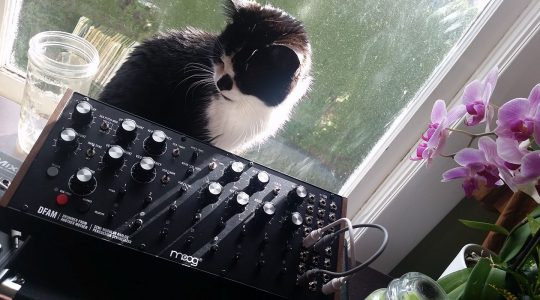
Carmen returns with her Moog DFAM (Drummer from another Mother), courtesy of Julia More, aka The Synth Witch. And yes, this is clearly her DFAM 😸
You can all of Carmen’s appearances on CatSynth via this link.


Carmen returns with her Moog DFAM (Drummer from another Mother), courtesy of Julia More, aka The Synth Witch. And yes, this is clearly her DFAM 😸
You can all of Carmen’s appearances on CatSynth via this link.
It’s time for another round of catch-up on recent musical adventures around the Bay Area. And so today we look back at last month’s performance by Rent Romus’ Life’s Blood Ensemble at the Ivy Room in Albany, California, where the celebrated the release of their new album Rogue Star. It was the subject of a recent episode of CatSynth TV.
As Romus explained on stage (and in our video), Rogue Star is a deliberate reference and homage to David Bowie’s final masterpiece Black Star. In particular, it is inspired by the work of saxophonist Donnie McCaslin (Romus’ brother-in-law) on Black Star. Indeed, the title track of the new album as performed that night did reference the style and material of McCaslin’s work. But this was a point of departure, and the ensemble moved in different directions as they performed other tracks from the new album.

Several of the band members contributed compositions to the album and to the performance that evening, including “Think!” by Heikki Koskinen (e-trumpet) and “Space is Expanding” by Safa Shokrai. Shokrai’s piece picked up on the theme of space and cosmos that winds through many of Life’s Blood Ensemble pieces as well as through Romus’ other projects. Koskinen’s composition offered frenetic ensemble runs punctuated by silences and small staccato hits from his e-trumpet as well as other instruments.
Rounding out the ensemble were Mark Clifford on vibraphone, Timothy Orr on drums, and Joshua Marshall on tenor saxophone. As always, I was impressed at the way the ensemble functioned as a unit, whether in the middle of a swinging “cool jazz” idiom or more seemingly free and chaotic sections. In some ways, it is in the silences between phrases where this is most apparent.
Before closing, I should also say something about the Ivy Room. This venerable institution has gone through multiple incarnations in the ten years since I moved to San Francisco and started playing and attending shows there. Of course, I had a lot of fun performing at “Hootenannies” back in 2008, 2009 and 2010, and enjoyed the kitschy decor. But from a musical point of view – and especially a jazz-ensemble point of view – this current incarnation is the best, with a sizable stage, lighting and sound reinforcement. I hope to bring my current band there sometime soon.
This is such heartbreaking news. Bento, the Keyboard Cat has passed away 😿
His humans made this wonderful tribute to Bento and his legacy, including many classic clips; and a sweet story about how he was a source of inspiration for his human companion, Charlie Schmidt.
Bento was actually the second Keyboard Cat. The original, Fatso, also lived with Schmidt but passed away in 1987, long before the age of internet memes. You can read more about the story of Fatso, Bento, and Schmidt at the Keyboard Cat Wikipedia page. Like my cats, Bento was a shelter cat and became a public face for the Shelter Pet Project. We saw him featured in billboards and bus stops here in San Francisco.
Keyboard Cat has always been a favorite of mine – how could it not, given the combination of interests. We always had fun with the early “play him/her off” videos, and it became a frequent tag-line of mine to say “You have been played off by the Keyboard Cat”, especially when someone loses a political election. I wish we had been able to cross paths in person.
We at CatSynth extend our sympathies to Charlie Schmidt and the rest of Bento’s family. Rest in peace, Keyboard Cat, you have been played off. 💕
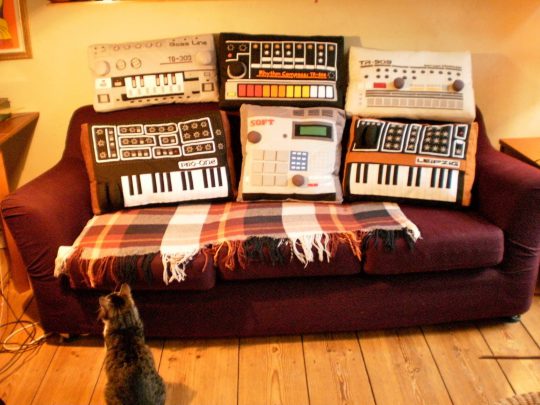
A cat contemplates a sofa full of synth pillows by softmachines. We can only imagine what happens next 😸
Softmachines makes pillows and cushions based on classic electronic musical instruments. For more, visit their shop. These are so cute, we need one at HQ.
We recently found this pic featuring a cute cat and a Korg Polysix on matrixsynth.
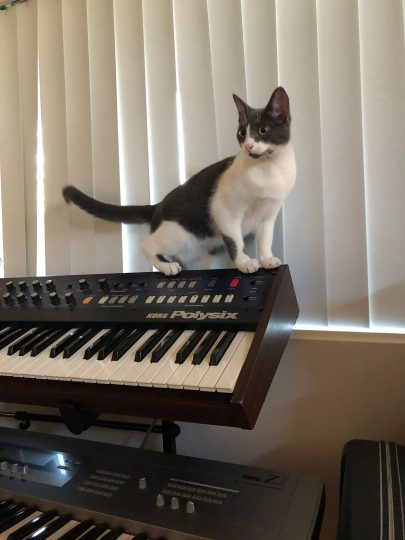
More from the matrixsynth post, where you can also see more photos:
via this auction
“Sadly, something has to give. Too much kit in my life!
This is a 1982 Korg Polysix in excellent condition. It’s been fully restored within the past two years, and is in really good cosmetic condition. If you’re looking here, you know the specifications already, so no need for copypasta here.
Work done:
Old NiCad battery replaced with a brand-new NiMH battery. Not a lithium cell. The CPU card was blissfully unharmed by the usual battery leak problems that these get – check the photos.
The power supply transformer has been replaced with a super quiet, efficient toroidal unit, capable of running at 220V as well as 110V.
One VCF chip – an SSM2044 – was replaced with a brand-new old stock item.
Synth was completely recalibrated and tuned and is working perfectly.
A Tauntek MIDI input board was fitted. This really enhances the machine by allowing MIDI note in, as well as syncing the arpeggiator clock over MIDI.Yes, I changed out the LEDs for blue ones, while replacing some scratchy, worn pots. Series resistors were recalculated to dial back the intensity. It’s not as piercing as in the photos. Will take some more pics soon. I think they really match the panel decals well, by YMMV. I’m happy to change them back to generic red (or anything, really) for the lucky buyer.”
No, it does not appear that the cat is included.
Additionally, there is a sample of a bass line played on this synth.
“A rather familiar bass-line. I’m just testing a newly-repaired Korg Polysix. This is playing in unison mode, although with only five ganged voices. No effects other than a small amount of reverb.”
When I went synth shopping for the first time in the mid 1980s (right after a birthday), among the first I encountered was one of this instrument’s more modest successors, the Korg Poly 800 II. The Polysix was long gone from the catalogs by then, and it was the time when digital synths were eclipsing analog instruments. I was quickly pulled in the direction of the Yamaha synths that dominated that era.
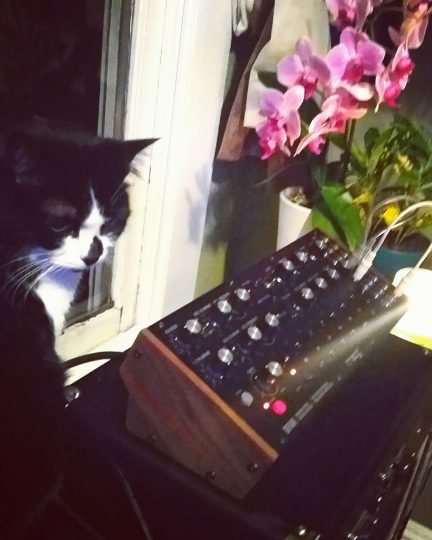
Carmen is eager to try out the new Moog DFAM (“Drummer From Another Mother”). We would love to try one out, too 😻
From our friend and fellow traveler Julia More, aka The Synth Witch.
You can see Carmen’s previous appearance here.
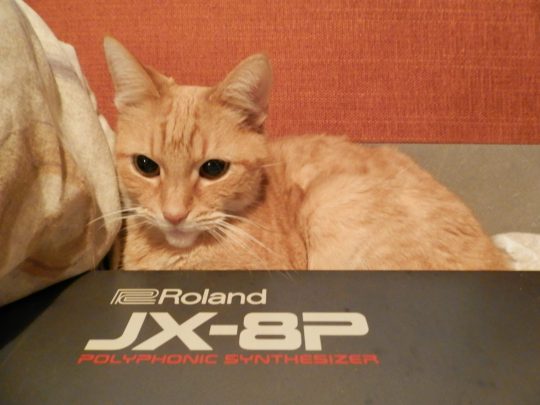
Miep returns to CatSynth, this time with a Roland JX-8P. You can see some of Miep’s previous appearances via this tag.
The JX-8P was a follow-up to Roland’s popular JX-3P. Some more info on it from Vintage Synth Explorer:
Though it is far more advanced than its predecessor, the JX-3P, the JX-8P has its drawbacks. Hands-on programming is sacrificed and reduced to assigning the parameter you want to tweak to a data-slider near the pitch/mod bender. Enter the PG-800 controller which gives you total control of all the JX-8P’s editable parameters with hands-on traditional slider control. Membrane buttons dominate the front panel of the JX-8P providing access to the various preset and user patches and to page through and assign editable parameters.
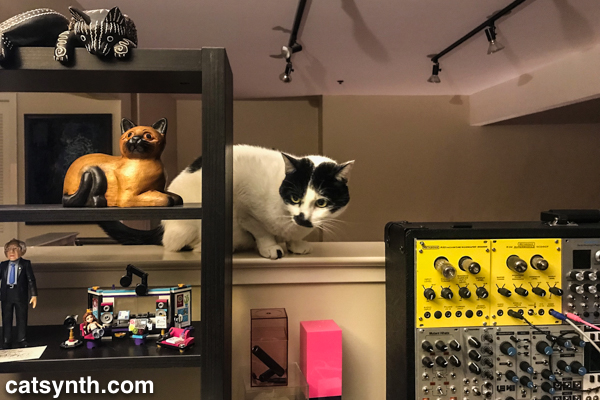
Sometimes Sam Sam ends up in CatSynth pics of her own, as when she recently got up to explore the redesigned studio space. She is fascinated by the new decorative shelves as well as the narrow band between the video/office corner and the modular synth.
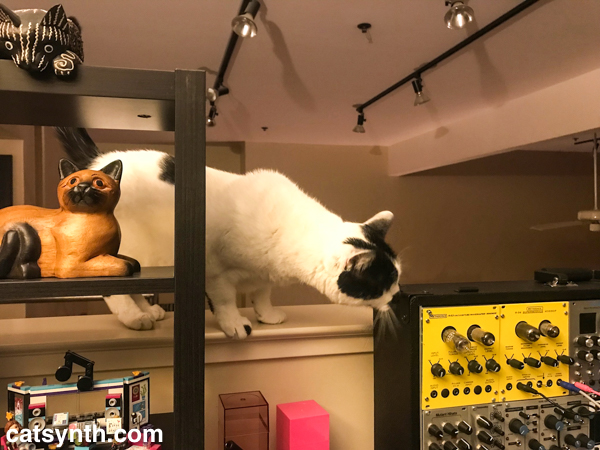
Perhaps she is picking up some scents on the modular case from our recent live performances.
I have been having a lot of fun in the studio lately, especially making videos and exploring our synthesizer collection in greater depth. I really should be working on some more formal compositions, but it seems I am in more of experimenting and exploratory mood at the moment. I have also, unfortunately, been battling insomnia. It ebbs and flows, and on the worst night (about a week ago), I decided to sit up for a while and play with the Roland JP-08 boutique synth.
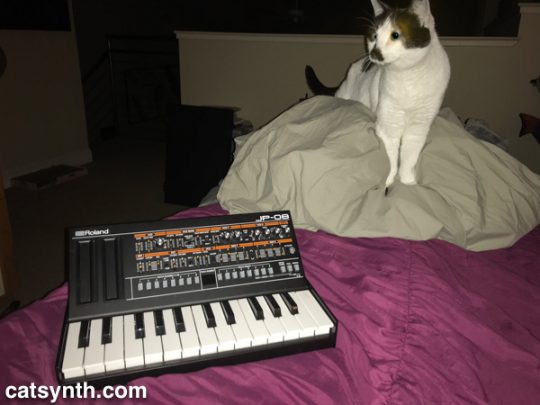
The size is actually ideal for playing in bed late at night. I spent some time exploring the architecture (it’s basically a Jupiter 8 with a few extensions) and came up with some new and unusual patches. We hope to share them with you in an upcoming CatSynth TV.